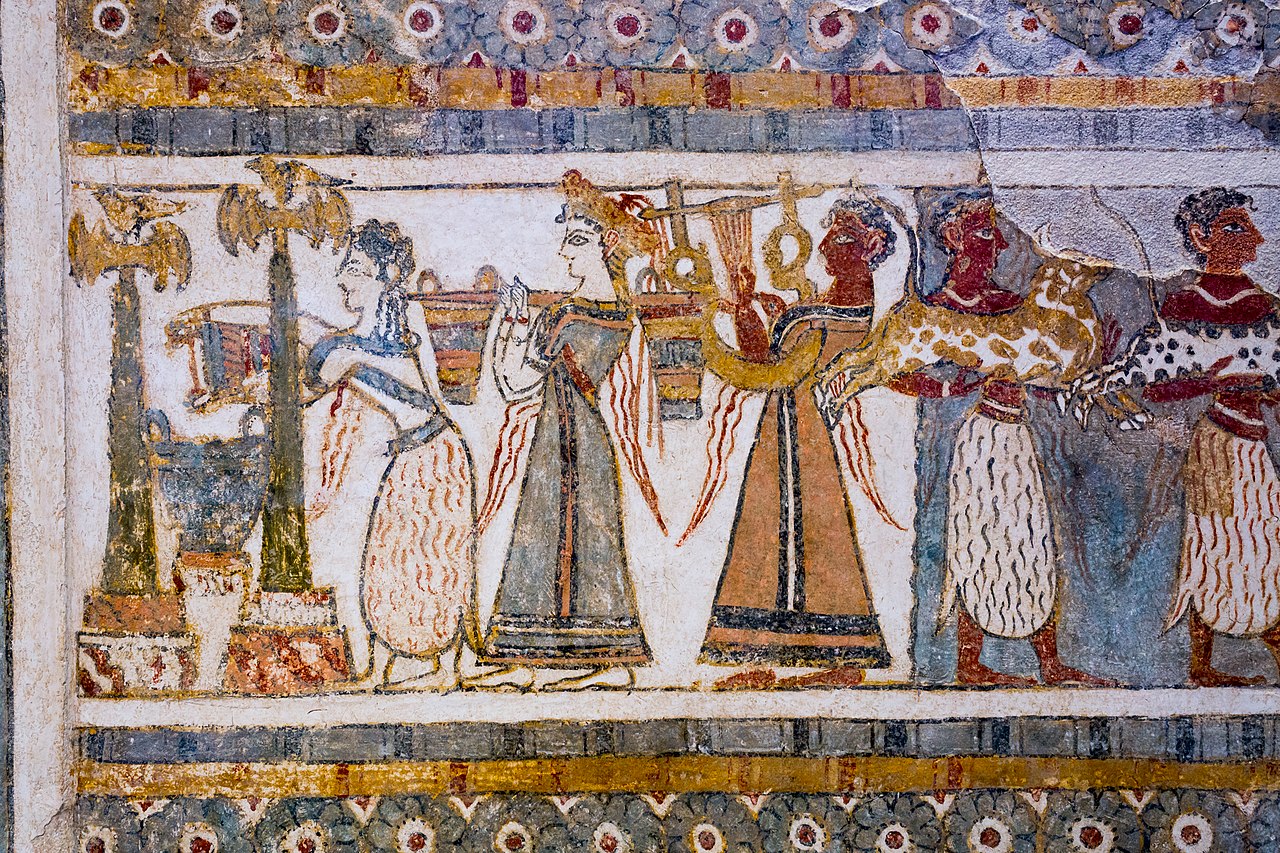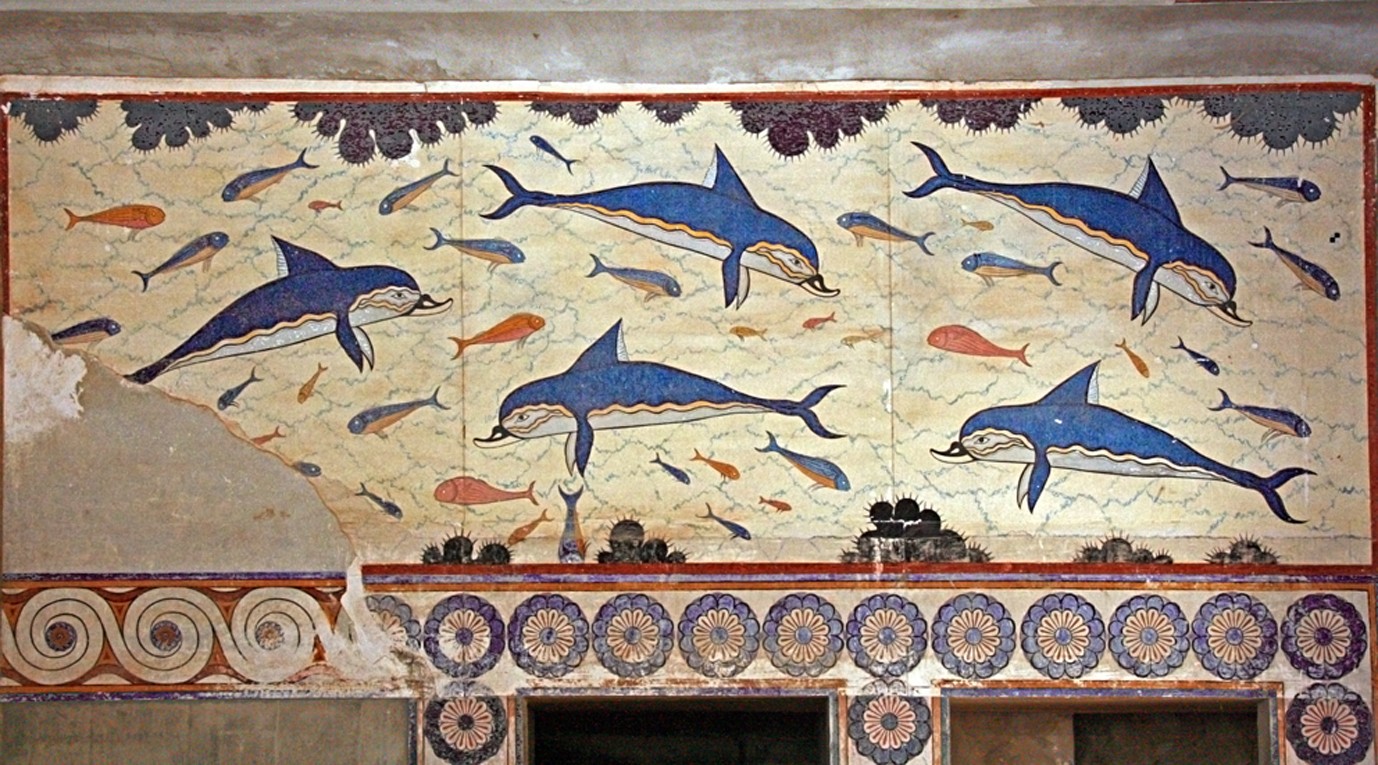The Minoan civilization
The Minoan civilization, flourishing on the island of Crete from approximately 3000 BCE to 1450 BCE, is one of the earliest advanced societies in Europe. Renowned for its palatial architecture, sophisticated art, and extensive trade networks, the Minoans played a pivotal role in the cultural and economic development of the Aegean and Eastern Mediterranean. Their achievements in art, architecture, and governance set the stage for subsequent civilizations, including the Mycenaeans, who succeeded them.

Map of Minoan Crete. Source: Wikimedia Commonsꜛ (license: CC BY-SA 3.0)
Origins and early development
The origins of the Minoan civilization trace back to Neolithic settlements on Crete, which evolved into complex communities during the Early Bronze Age (ca. 3000 BCE). The strategic location of Crete in the Aegean Sea facilitated trade with neighboring regions, including Egypt, Mesopotamia, and the Cycladic islands. Early Minoan societies benefited from this connectivity, adopting technological and cultural innovations such as metallurgy, pottery-making, and agricultural practices.
 Mediterranean, Mesopotamian and Egypt civilizations around 1230/20 BCE, with the Hittite Empire in blue, Egypt in yellow, the Assyrian Empire in green – and the Mykenaean civilization in purple. At that time, the Minoan civilization had already declined and became part of the Mykenaean civilization. Source: Wikimedia Commonsꜛ (license: CC BY-SA 3.0)
Mediterranean, Mesopotamian and Egypt civilizations around 1230/20 BCE, with the Hittite Empire in blue, Egypt in yellow, the Assyrian Empire in green – and the Mykenaean civilization in purple. At that time, the Minoan civilization had already declined and became part of the Mykenaean civilization. Source: Wikimedia Commonsꜛ (license: CC BY-SA 3.0)
The emergence of palatial centers around 2000 BCE, such as Knossos, Phaistos, and Malia, marked a significant transition in Minoan society. These centers served as administrative, religious, and economic hubs, coordinating agricultural production, artisanal craftsmanship, and regional trade. The centralization of power and resources enabled the Minoans to establish a highly organized and prosperous society.
 Figures from the Agia Triada Sarcophagus. Source: Wikimedia Commonsꜛ (license: CC BY-SA 4.0)
Figures from the Agia Triada Sarcophagus. Source: Wikimedia Commonsꜛ (license: CC BY-SA 4.0)
Cultural achievements and social organization
The Minoan civilization is particularly celebrated for its artistic and architectural accomplishments. Frescoes depicting vibrant scenes of nature, religious rituals, and daily life adorned the walls of Minoan palaces, reflecting a society deeply connected to its environment and cultural traditions. The “Toreador Fresco” and the “Prince of the Lilies” are iconic examples of Minoan art, showcasing their mastery of color and movement.
 The Spring Fresco from Akrotiri, Thera, dated to c. 16th century BCE. Source: Wikimedia Commonsꜛ (license: CC BY-SA 4.0)
The Spring Fresco from Akrotiri, Thera, dated to c. 16th century BCE. Source: Wikimedia Commonsꜛ (license: CC BY-SA 4.0)
 Ship Procession Fresco. Fresco of a ship procession from bronze age excavation at Akrotiri, on the greece island Santorini. Source: Wikimedia Commonsꜛ (license: public domain)
Ship Procession Fresco. Fresco of a ship procession from bronze age excavation at Akrotiri, on the greece island Santorini. Source: Wikimedia Commonsꜛ (license: public domain)
Minoan palaces, characterized by their complex layouts, open courtyards, and advanced infrastructure, symbolize the sophistication of their society. The palace at Knossos, often associated with the myth of King Minos and the Minotaur, is the largest and most elaborate, featuring storerooms, workshops, and ceremonial spaces. These architectural feats were complemented by advanced water management systems, including aqueducts and drainage networks.
 The Palace of Knossos, the largest Minoan palace. Source: Wikimedia Commonsꜛ (license: CC BY-SA 3.0)
The Palace of Knossos, the largest Minoan palace. Source: Wikimedia Commonsꜛ (license: CC BY-SA 3.0)
 Reconstruction of the Palace of Knossos. Source: Wikimedia Commonsꜛ (license: CC BY-SA 3.0)
Reconstruction of the Palace of Knossos. Source: Wikimedia Commonsꜛ (license: CC BY-SA 3.0)
Socially, the Minoans appear to have been a relatively egalitarian society, with limited evidence of centralized monarchies. Instead, power may have been distributed among elite families or councils, supported by a class of artisans, merchants, and farmers. The prominence of women in Minoan art and religious iconography suggests they held significant roles in society, possibly as priestesses or community leaders.
 The mostly reconstructed ‘Campstool Fresco’ from Knossos. Source: Wikimedia Commonsꜛ (license: public domain)
The mostly reconstructed ‘Campstool Fresco’ from Knossos. Source: Wikimedia Commonsꜛ (license: public domain)
 The (incomplete) Harvester Vase, soapstone. Source: Wikimedia Commonsꜛ (license: CC BY-SA 3.0)
The (incomplete) Harvester Vase, soapstone. Source: Wikimedia Commonsꜛ (license: CC BY-SA 3.0)
 A depiction of elite Minoan women. Source: Wikimedia Commonsꜛ (license: public domain)
A depiction of elite Minoan women. Source: Wikimedia Commonsꜛ (license: public domain)
Religion played a central role in Minoan culture, with worship centered on nature deities, sacred animals, and fertility symbols. Ritual practices often took place in palaces, caves, and mountaintop sanctuaries, emphasizing a close relationship between the Minoans and their natural environment. Bull-leaping, a recurring motif in Minoan art, may have held religious significance, symbolizing strength, fertility, or divine favor.
 Bull-Leaping Fresco. Fresco found in Knossos palace, Crete, Greece, dated 1600 - 1450 BCE. Source: Wikimedia Commonsꜛ (license: CC BY-SA 1.0)
Bull-Leaping Fresco. Fresco found in Knossos palace, Crete, Greece, dated 1600 - 1450 BCE. Source: Wikimedia Commonsꜛ (license: CC BY-SA 1.0)


Left: Close-up of central figure of the Taureador Fresco. Source: Wikimedia Commonsꜛ (license: CC BY-SA 3.0) – Right: Close-up of right figure of the Taureador Fresco. Source: Wikimedia Commonsꜛ (license: CC BY-SA 3.0)
 Bronze sculpture showing an acrobat leaping over a bull’s head, Crete, Minoan, about 1700-1450 BCE. Source: Wikimedia Commonsꜛ (license: CC BY-SA 2.0)
Bronze sculpture showing an acrobat leaping over a bull’s head, Crete, Minoan, about 1700-1450 BCE. Source: Wikimedia Commonsꜛ (license: CC BY-SA 2.0)

Trade and connectivity
The Minoan civilization thrived on its maritime trade networks, connecting Crete to the wider Mediterranean world. Minoan merchants exchanged goods such as olive oil, wine, textiles, and pottery for luxury items like gold, ivory, and precious stones. Their trade with Egypt, evidenced by Minoan artifacts found in the Nile Delta, facilitated the exchange of cultural and technological innovations.
 Cretans (kftjw) bringing gifts to Egypt, in the Tomb of Rekhmire, under Pharaoh Thutmosis III (c. 1479-1425 BCE). Source: Wikimedia Commonsꜛ (license: public domain)
Cretans (kftjw) bringing gifts to Egypt, in the Tomb of Rekhmire, under Pharaoh Thutmosis III (c. 1479-1425 BCE). Source: Wikimedia Commonsꜛ (license: public domain)
This connectivity also extended to Mesopotamia, where Minoan seals and artifacts have been discovered, indicating interaction with the ancient Near East. The influence of Minoan craftsmanship and iconography is visible in the Cyclades and mainland Greece, where local cultures adopted Minoan styles and techniques. This cultural diffusion underscores the central role of Crete in the economic and artistic networks of the Bronze Age.
Comparison with Mesopotamia, Egypt, and the Mycenaean civilization
The Minoan civilization shares similarities and differences with Mesopotamia, Egypt, and the Mycenaean civilization. Like Mesopotamia, the Minoans developed complex urban centers that served as administrative and economic hubs. However, unlike the city-states of Mesopotamia, Minoan society lacked evidence of militaristic conquest, suggesting a focus on trade and diplomacy over territorial expansion.
Egyptian influence on Minoan art and religion is evident in shared motifs such as lotus flowers, sphinxes, and ritual practices. However, while Egypt centralized power under divine kingship, Minoan governance appears more decentralized, with a greater emphasis on community and shared leadership.
The Mycenaean civilization, which emerged on mainland Greece around 1600 BCE, inherited many aspects of Minoan culture, including art, architecture, and religious practices. However, the Mycenaeans were more militaristic, as evidenced by their fortified citadels and warrior graves, contrasting with the relatively peaceful nature of Minoan society. The eventual decline of the Minoans, possibly due to a combination of natural disasters and Mycenaean conquest, marked a shift in Aegean power dynamics.
Decline and legacy
The decline of the Minoan civilization began around 1450 BCE, coinciding with a series of natural disasters, including earthquakes and the eruption of Thera (modern Santorini). These events likely disrupted agricultural production and trade, weakening the economic foundation of Minoan society. The subsequent invasion and assimilation by the Mycenaeans marked the end of Minoan dominance in the Aegean.
 The Dolphin fresco from Knossos. Source: Wikimedia Commonsꜛ (license: CC BY-SA 3.0)
The Dolphin fresco from Knossos. Source: Wikimedia Commonsꜛ (license: CC BY-SA 3.0)
Despite their decline, the legacy of the Minoans endures. Their artistic and architectural innovations influenced later Greek culture, including the development of mythology, aesthetics, and urban planning. The story of King Minos and the labyrinth remains a powerful symbol of Minoan ingenuity and creativity, underscoring their lasting impact on Western civilization.
References
- Sinclair Hood, The Arts in Prehistoric Greece, 1992, Yale University Press, ISBN: 978-0300052879
- Arthur Cotterell, The Minoan World, 1979, Scribner, ISBN: 978-0718118464
- Rodney Castleden, Minoans: Life in Bronze Age Crete, 1990, Routledge, ISBN: 978-0415088336
- Nanno Marinatos, Minoan Religion: Ritual, Image, and Symbol, 1993, University of South Carolina Press, ISBN: 978-0872497443
- John Chadwick, The Mycenaean World, 1976, Cambridge University Press, ISBN: 978-0521290371
- David W. Phillipson, Ancient Ethiopia: Aksum, Its Antecedents and Successors, 2002, British Museum Press, ISBN: 978-0714127637
- Colin Renfrew, The Emergence of Civilization: The Cyclades and the Aegean in the Third Millennium BCE, 2017, Oxbow Books, ISBN: 9780416169102.
- Peter Warren and Vronwy Hankey, Aegean Bronze Age Chronology, 1989, Gerald Duckworth & Co Ltd, ISBN: 978-0906515679
- Helene Whittaker, Religion and Society in Middle Bronze Age Greece, 2014, Cambridge University Press, ISBN: 978-1107049871
- Eric H. Cline, 1177 B.C.: The Year Civilization Collapsed, 2021, Princeton University Press, ISBN: 978-0691208015


















comments